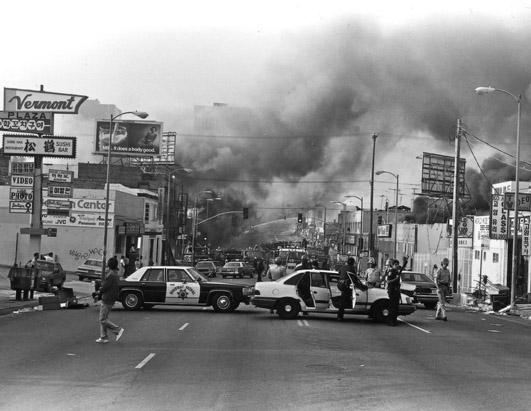“[T]he designers of malls and pseudo-public space
attack the crowd by homogenizing it… They set up architectural and semiotic
barriers to filter out ‘undesirables’. They enclose the mass that remains,
directing its circulation with behaviorist ferocity… lured by visual stimuli of
all kinds…”
Mike Davis, City
of Quartz, Excavating the Future of
Los Angeles, 1990, p. (226).
My new novel includes a chapter about Los Angeles 1992 when an art show called helter skelter and riot broke out, waking up the world. Exposing the dirty little secret of the lingering problem of racism in the USA, the riot reminded us all there was more to do. And many spent the next quarter century doing the work. Back in 1992, it was jarring.
All spring
long, we followed the case of the police officers who beat up Rodney King. Everyone had always told us don’t drive
through South Central. With the riots,
South Central came to us. It screamed this is not ok. A city divided will burn. This racism is a cancer that will eat away at
the body of the city. We all saw videos of the man lying face down on the
pavement. There were only a few
more weeks to go in school. We’d been studying Viet Nam in Brodie’s US history
class, reflecting on people being left behind.
Things were getting odd with the trial, which had been moved to Semi
Valley away where King was beaten. The day of the verdict, a palpable disgust
filled the air. But instead of sitting
with it, people acted up, as they had in 1965 in Watts. It was beautiful and horrible to watch the
smoke rise in the distance after the city began to blaze.
The
headlines from the April 30, 1992 page-one headline of the L.A. Times declared: “All 4 in King Beating Acquitted, Violence
Follows Verdicts; Guards Called Out.” The headline was accompanied by photos of
relieved baby-faced police officers hugging one another to the left and rioters
against a backdrop of flames to the right. The night before, we’d watched 5
o’clock news commentators attempting to grasp the significance of the unrest
erupting across the city. Our experience of these riots and the other uprisings
of the era—the Fall of the Wall, etc.—was filtered through cloudy media lenses. But the image of the fires and smoke rising
from downtown felt very real. This could
not remain a divided city. If the city
was going to ignore the poverty and desolation.
Over the next few days, riots spread throughout the city, including to Beverly
Hills where Grant and his sister watched armed police seem to take over.
“There
are riots cops down the streets, here in Beverly Hills,” Grant reflected in
awe. The infection below the surface of the city had exploded for everyone to
see. The inequality, that everyone seemed
to ignore, was not to lay dormant.
On campus, we hit the streets. “It’s been 400 years baby! 400 years!!!”
noted a fellow student, who was African American, as he sang and chanted with the others, out
in the street. The cathartic plea during the post-verdict street actions during
the riots in Los Angeles in 1992 spoke to a collective hope for something else,
possibly we could find our way together. The expression seemed to be a
cathartic release. Looking out there, we
saw that a cancer at the center of Los Angeles that could not be ignored,
without more riots. There had to be an
alternative to the state-programmed default of
gang life, drugs, violence, and prisons,
But we did not know what it could be. But there had to be more than a warfare
state characterized by mass incarceration, HIV/AIDS, police corruption and
brutality, and widespread loss. There
was something telling about being moved to take the streets, even if one could
put words around what that desire means.
After students were ripped out of
their cars, the campus was quarantined. When the policemen accused of beating
Rodney King were tried in a suburban court by ten white people, one Hispanic
and one Filipino woman—and no black jurors—the ensuing acquittals invoked a
stinging sense of betrayal. Only 13 years before, in 1979, the San Francisco
White Night Riots occurred, when a jury that lacked a single gay juror gave
former policeman Dan White a slap on the wrist for the murders of Mayor George
Moscone and Councilman Harvey Milk. Citizens in 1979 and 1992, in San Francisco
and L.A., had maintained faith that criminal justice would do the right
thing.
After the
LA riots America's shadow reared her ugly head.
I wasn't prepared for what I saw, with people tearing each other out of
cars, beating each other, flames erupting through the streets. History felt alive as it had never felt in my
life. I had always seen civil
disruptions as things that happened somewhere else – in Prague 1989, in Chicago
in 1968, not on my campus, not in 1992.
But the world was changing.
People were acting up. Darby
might have been gone, but another cohort were hitting the streets. It all felt alive. Something was changing in
the world and in me.









No comments:
Post a Comment